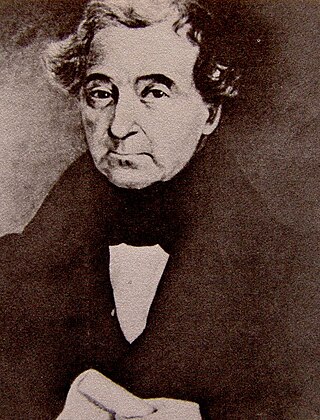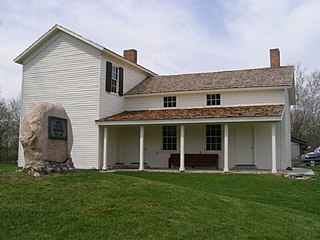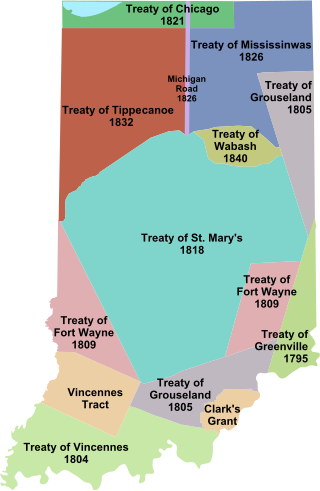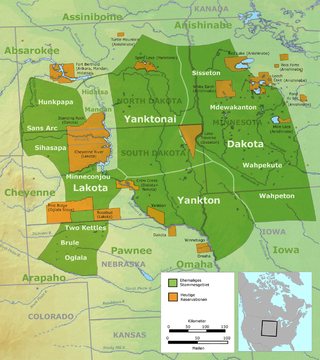Related Research Articles

The Miami are a Native American nation originally speaking one of the Algonquian languages. Among the peoples known as the Great Lakes tribes, they occupied territory that is now identified as north-central Indiana, southwest Michigan, and western Ohio. The Miami were historically made up of several prominent subgroups, including the Piankeshaw, Wea, Pepikokia, Kilatika, Mengakonkia, and Atchakangouen. In modern times, Miami is used more specifically to refer to the Atchakangouen. By 1846, most of the Miami had been forcefully displaced to Indian Territory. The Miami Tribe of Oklahoma are the federally recognized tribe of Miami Indians in the United States. The Miami Nation of Indiana, a nonprofit organization of self-identified descendants of Miamis who were exempted from removal, have unsuccessfully sought separate recognition.

The Treaty of Greenville, also known to Americans as the Treaty with the Wyandots, etc., but formally titled A treaty of peace between the United States of America, and the tribes of Indians called the Wyandots, Delawares, Shawanees, Ottawas, Chippewas, Pattawatimas, Miamis, Eel Rivers, Weas, Kickapoos, Piankeshaws, and Kaskaskias was a 1795 treaty between the United States and indigenous nations of the Northwest Territory, including the Wyandot and Delaware peoples, that redefined the boundary between indigenous peoples' lands and territory for European American community settlement.

The Wea were a Miami-Illinois-speaking Native American tribe originally located in western Indiana. Historically, they were described as either being closely related to the Miami Tribe or a sub-tribe of Miami.

Jean Baptiste de Richardville, also known as Pinšiwa or Peshewa in the Miami-Illinois language or John Richardville in English, was the last akima 'civil chief' of the Miami people. He began his career in the 1790s as a fur trader who controlled an important portage connecting the Maumee River to the Little River in what became the present-day state of Indiana. Richardville emerged a principal chief in 1816 and remained a leader of the Miamis until his death in 1841. He was a signatory to the Treaty of Greenville (1795), as well as several later treaties between the U.S. government and the Miami people, most notably the Treaty of Fort Wayne (1803), the Treaty of Fort Wayne (1809), the Treaty of Saint Mary's (1818), the Treaty of Mississinewas (1826), the treaty signed at the Forks of the Wabash (1838), and the Treaty of the Wabash (1840).
The Treaty of Mississinewas or the Treaty of Mississinewa also called Treaty of the Wabash is an 1826 treaty between the United States and the Miami and Potawatomi Tribes regarding purchase of Indian lands in Indiana and Michigan. The signing was held at the mouth of the Mississinewa River on the Wabash, hence the name.

The Treaty of St. Mary's may refer to one of six treaties concluded in fall of 1818 between the United States and Natives of central Indiana regarding purchase of Native land. The treaties were

Historic Forks of the Wabash is a historic museum park near Huntington, Indiana, that features several historic buildings, trails and remnants of the Wabash and Erie Canal. The location was the signing location of the historic Treaty at the Forks of the Wabash in 1838. The park is located along the Wabash River. It was listed on the National Register of Historic Places in 1985 as the Chief Richardville House and Miami Treaty Grounds.

The Treaty of Fort Wayne, sometimes called the Ten O'clock Line Treaty or the Twelve Mile Line Treaty, is an 1809 treaty that obtained 29,719,530 acres of Native American land for the settlers of Illinois and Indiana. The negotiations primarily involved the Delaware tribe but included other tribes as well. However, the negotiations excluded the Shawnee, who were minor inhabitants of the area and had previously been asked to leave by Miami War Chief Little Turtle. Territorial Governor William Henry Harrison negotiated the treaty with the tribes. The treaty led to a war with the United States begun by Shawnee leader Tecumseh and other dissenting tribesmen in what came to be called "Tecumseh's War".

Papakeecha was the most influential Miami chief in the region around Lake Wawasee, in what is now Kosciusko County, Indiana, United States leading his people from 1820 until 1837. Lake Papakeechie was named after him.

Indian removals in Indiana followed a series of the land cession treaties made between 1795 and 1846 that led to the removal of most of the native tribes from Indiana. Some of the removals occurred prior to 1830, but most took place between 1830 and 1846. The Lenape (Delaware), Piankashaw, Kickapoo, Wea, and Shawnee were removed in the 1820s and 1830s, but the Potawatomi and Miami removals in the 1830s and 1840s were more gradual and incomplete, and not all of Indiana's Native Americans voluntarily left the state. The most well-known resistance effort in Indiana was the forced removal of Chief Menominee and his Yellow River band of Potawatomi in what became known as the Potawatomi Trail of Death in 1838, in which 859 Potawatomi were removed to Kansas and at least forty died on the journey west. The Miami were the last to be removed from Indiana, but tribal leaders delayed the process until 1846. Many of the Miami were permitted to remain on land allotments guaranteed to them under the Treaty of St. Mary's (1818) and subsequent treaties.

The Treaty of Tippecanoe was an agreement between the United States government and Native American Potawatomi tribes in Indiana on October 26, 1832.

The Treaty of Fort Wayne was a treaty between the United States and several groups of Native Americans. The treaty was signed on June 7, 1803 and proclaimed December 26, 1803. It more precisely defined the boundaries of the Vincennes tract ceded to the United States by the Treaty of Greenville, 1795.

Tecumseh's confederacy was a confederation of indigenous peoples of the Great Lakes region of North America that began to form in the early 19th century around the teaching of Tenskwatawa, called The Prophet by his followers. The confederation grew over several years and came to include several thousand warriors. Shawnee leader Tecumseh, the brother of The Prophet, developed into the leader of the group as early as 1808. Together, they worked to unite the various tribes against the European settlers who had been crossing the Appalachian Mountains and settling on their land.

The Yankton Treaty was a treaty signed in 1858 between the United States Government and the Yankton Sioux Tribe, that ceded most of eastern South Dakota to the U.S. Government. The treaty was signed in April 1858, and ratified by the United States Congress on February 16, 1859.

Francis Godfroy was a chief of the Miami people. He negotiated treaties with between his tribe and the United States.
The Miami Nation of Indiana is a group of individuals who identify as Miami and have organized as a 501(c)(3) nonprofit organization. The group's headquarters are at Peru, Indiana.

The Treaty of the Wabash was an agreement between the United States government and Native American Miami tribes in Indiana on November 28, 1840.

The Treaty of Pontotoc Creek was a treaty signed on October 20, 1832 by representatives of the United States and the Chiefs of the Chickasaw Nation assembled at the National Council House on Pontotoc Creek in Pontotoc, Mississippi. The treaty ceded the 6,283,804 million acres of the remaining Chickasaw homeland in Mississippi in return for Chickasaw relocation on an equal amount of land west of the Mississippi River.
Indian removals in Ohio started in the late eighteenth century after the American victory in the Revolutionary War and the consequent opening of the Northwestern United States to European-American settlement. Native American tribes residing in the region banded together to resist settlement, resulting in the disastrous Northwest Indian War where the Native tribes ceded large swathes of territory to the American government. After the American victory in the war, several Indian reservations were established to forcibly relocate landless tribes to. The process of obtaining full American sovereignty over Indian territories in Ohio was complete around 1818, but continued in Indiana until 1840.
References
- ↑ Library, Oklahoma State University. "INDIAN AFFAIRS: LAWS AND TREATIES. Vol. 2, Treaties". digital.library.okstate.edu. Retrieved 2016-08-15.
- ↑ https://mc.miamioh.edu/aacimwahkionkonci/event/34